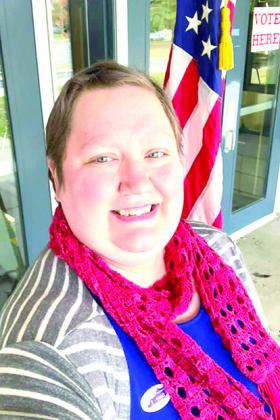The 2020 Presidential election was poised to be contentious, historical election that was being promoted by both sides as the most important of our lifetime.
With recent circumstances where the virus has devastated the economy and put the makeup of the election in doubt, it has proven even more so.
A 100 years ago on November 2, there was truly a historical eleciton. One that saw women have the right to vote for the first time in United States history.
Pendleton County native Jessica Faulhaber is a fiber artist who is honoring that moment through a Facebook page 100 years Shawl a Long.
“We are making red shawls (woven, knit, and crochet) throughout the year and planning to wear them for next years Election,” she said.
The red shawl is an ode to Susan B. Anthony who wore a red shawl and was famous for it.
Faulhaber was watching a documentary that told the story of how Tennessee became the 36th state to ratify the 19th Amendment that gave the woman a voice in the political process.
“Susan B. Anthony’s shawl she wore was so infamous that when she wore another shawl for a speech, they refused to report. She had someone go get the shawl from where she was staying and they reported. Her shawl is the inspiration,” said Faulhaber.
After protestors held a massive suffrage parade in the nation’s capital on the eve of President Woodrow Wilson’s inauguration in 1913, Alice Paul founded the Congressional Union for Woman Suffrage that same year. It later became the National Woman’s Party.
In 1918, President Wilson switched his stance on women’s voting rights from objection to support.
As reported in The New York Times on October 1, 1918, Wilson said, “I regard the extension of suffrage to women as vitally essential to the successful prosecution of the great war of humanity in which we are engaged.”
Despite his support, the effort failed in the Senate by two votes.
On May 21, 1919, another measure was proposed in the House, and it passed 304 to 89, a full 42 votes above the required two-thirds majority.
Two weeks later, the U. S. Senate passed the 19th Amendment by two votes over the two-thirds required majority, 56-25.
By March of 1920, 35 states had ratified the amendment while seven states had rejected it. Kentucky was among the movement with advocay for both African-Americans and women. Mary Barr Clay, daughter of abolitionist Cassius M. Clay, served as vice-president of both the National Woman Suffrage Association and the American Woman Suffrage Association.
Eight million women across the U. S. voted in elections that November and millions more will do the same this November for not only the choice between Donald J. Trump and Joe Biden among other candidates but also for other federal elections and state and local races.
“. If someone want ms to be involved they are welcome to join our Facebook group and Ravelry group both named 100 years shawl a long,” said Faulhaber.
She encourages those interested to post photos or comments about their progress and ask questions. She is also posting history facts along the way.
With many households sitting at home and looking for something to do, this is a great time to be involved, learn a little history or teach some to your family and honor some of the heroes of year’s past.
Faulhaber encourages everyone no matter your knowledge or technical skills.
“You do not have to be an accomplished knitter or even a knitter at all. If you’d like a shawl, many ladies would appreciate a donation of yarn and be willing to make one. It’s very relaxed so that everyone feels welcome,” she said.
A Red shawl to honor the fight for women’s right to vote
Image
Body


